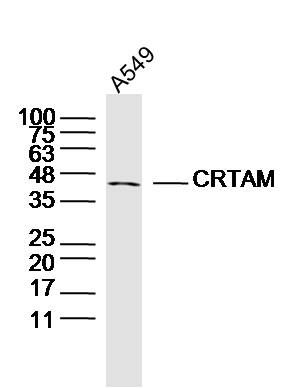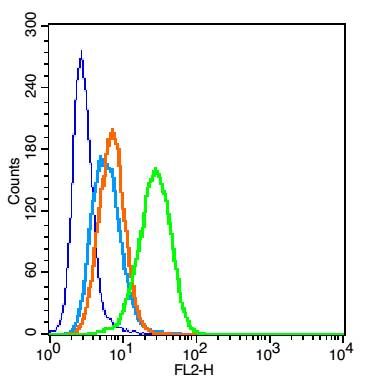CRTAM Polyclonal Antibody
Purified Rabbit Polyclonal Antibody (Pab)
- SPECIFICATION
- CITATIONS
- PROTOCOLS
- BACKGROUND

Application
| IHC-F, IF, ICC, E |
|---|---|
| Primary Accession | O95727 |
| Reactivity | Rat, Pig |
| Host | Rabbit |
| Clonality | Polyclonal |
| Calculated MW | 42 KDa |
| Physical State | Liquid |
| Immunogen | KLH conjugated synthetic peptide derived from human CRTAM |
| Epitope Specificity | 31-130/393 |
| Isotype | IgG |
| Purity | affinity purified by Protein A |
| Buffer | 0.01M TBS (pH7.4) with 1% BSA, 0.02% Proclin300 and 50% Glycerol. |
| SUBCELLULAR LOCATION | Membrane; Single-pass type I membrane protein (Potential). |
| SIMILARITY | Belongs to the nectin family.Contains 1 Ig-like C2-type (immunoglobulin-like) domain.Contains 1 Ig-like V-type (immunoglobulin-like) domain. |
| SUBUNIT | Interacts with CADM1. |
| Important Note | This product as supplied is intended for research use only, not for use in human, therapeutic or diagnostic applications. |
| Background Descriptions | CRTAM, (class-I MHC-restricted T-cell associated molecule), is an immunoglobulin-superfamily transmembrane protein and a new member of the nectin-like (Necls) family. In the immune system, CRTAM expression has been shown to be restricted to activated class-I MHC-restricted T cells, including NKT and CD8 T cells. CRTAM interacts with CADM1 and promotes natural killer (NK) cell cytotoxicity and interferon-gamma (IFN-gamma) secretion by CD8+ cells in vitro, as well as NK cell-mediated rejection of tumors expressing CADM3 in vivo. Nectin-like (Necl) molecule 2, has been identified as a ligand of CRTAM. Necl2/CRTAM molecular pair could regulate a large panel of cell/cell interactions both within and outside of the immune system. |
| Gene ID | 56253 |
|---|---|
| Other Names | Cytotoxic and regulatory T-cell molecule, Class-I MHC-restricted T-cell-associated molecule, CD355, CRTAM {ECO:0000312|EMBL:AAC80267.1} |
| Target/Specificity | In the immune system, expression is restricted to activated class-I MHC-restricted cells, including NKT and CD8 cells. Strongly expressed in spleen, thymus, small intestine, peripheral blood leukocyte, and in Purkinje neurons in cerebellum. Expressed at much lower levels in testis, ovary, colon, lung and lymphoid tissues. |
| Dilution | IHC-F=1:100-500,ICC=1:100-500,IF=1:100-500,ELISA=1:5000-10000 |
| Storage | Store at -20 ℃ for one year. Avoid repeated freeze/thaw cycles. When reconstituted in sterile pH 7.4 0.01M PBS or diluent of antibody the antibody is stable for at least two weeks at 2-4 ℃. |
| Name | CRTAM {ECO:0000312|EMBL:AAC80267.1} |
|---|---|
| Function | Mediates heterophilic cell-cell adhesion which regulates the activation, differentiation and tissue retention of various T-cell subsets (By similarity). Interaction with CADM1 promotes natural killer (NK) cell cytotoxicity and IFNG/interferon-gamma secretion by CD8+ T- cells in vitro as well as NK cell-mediated rejection of tumors expressing CADM1 in vivo (PubMed:15811952). Regulates CD8+ T-cell proliferation in response to T-cell receptor (TCR) activation (By similarity). Appears to be dispensable for CD8+ T-cell-mediated cytotoxicity (By similarity). Interaction with SCRIB promotes the late phase of cellular polarization of a subset of CD4+ T-cells, which in turn regulates TCR-mediated proliferation and IFNG, IL17 and IL22 production (By similarity). By interacting with CADM1 on CD8+ dendritic cells, regulates the retention of activated CD8+ T-cells within the draining lymph node (By similarity). Required for the intestinal retention of intraepithelial CD4+ CD8+ T-cells and, to a lesser extent, intraepithelial and lamina propria CD8+ T-cells and CD4+ T-cells (By similarity). Interaction with CADM1 promotes the adhesion to gut- associated CD103+ dendritic cells, which may facilitate the expression of gut-homing and adhesion molecules on T-cells and the conversion of CD4+ T-cells into CD4+ CD8+ T-cells (By similarity). |
| Cellular Location | Cell membrane {ECO:0000250|UniProtKB:Q149L7}; Single-pass type I membrane protein. Note=In a subset of CD4+ T-cells, colocalizes with SCRIB at the immunological synapse during the late phase of T-cell activation {ECO:0000250|UniProtKB:Q149L7} |
| Tissue Location | In the immune system, expression is restricted to activated class-I MHC-restricted cells, including NKT and CD8 T-cells (PubMed:10811014, PubMed:15811952, PubMed:16300832). Strongly expressed in spleen, thymus, small intestine, peripheral blood leukocyte, and in Purkinje neurons in cerebellum. Expressed at much lower levels in testis, ovary, colon, lung and lymphoid tissues (PubMed:16300832) |

Thousands of laboratories across the world have published research that depended on the performance of antibodies from Abcepta to advance their research. Check out links to articles that cite our products in major peer-reviewed journals, organized by research category.
info@abcepta.com, and receive a free "I Love Antibodies" mug.
Provided below are standard protocols that you may find useful for product applications.
If you have used an Abcepta product and would like to share how it has performed, please click on the "Submit Review" button and provide the requested information. Our staff will examine and post your review and contact you if needed.
If you have any additional inquiries please email technical services at tech@abcepta.com.













 Foundational characteristics of cancer include proliferation, angiogenesis, migration, evasion of apoptosis, and cellular immortality. Find key markers for these cellular processes and antibodies to detect them.
Foundational characteristics of cancer include proliferation, angiogenesis, migration, evasion of apoptosis, and cellular immortality. Find key markers for these cellular processes and antibodies to detect them. The SUMOplot™ Analysis Program predicts and scores sumoylation sites in your protein. SUMOylation is a post-translational modification involved in various cellular processes, such as nuclear-cytosolic transport, transcriptional regulation, apoptosis, protein stability, response to stress, and progression through the cell cycle.
The SUMOplot™ Analysis Program predicts and scores sumoylation sites in your protein. SUMOylation is a post-translational modification involved in various cellular processes, such as nuclear-cytosolic transport, transcriptional regulation, apoptosis, protein stability, response to stress, and progression through the cell cycle. The Autophagy Receptor Motif Plotter predicts and scores autophagy receptor binding sites in your protein. Identifying proteins connected to this pathway is critical to understanding the role of autophagy in physiological as well as pathological processes such as development, differentiation, neurodegenerative diseases, stress, infection, and cancer.
The Autophagy Receptor Motif Plotter predicts and scores autophagy receptor binding sites in your protein. Identifying proteins connected to this pathway is critical to understanding the role of autophagy in physiological as well as pathological processes such as development, differentiation, neurodegenerative diseases, stress, infection, and cancer.



